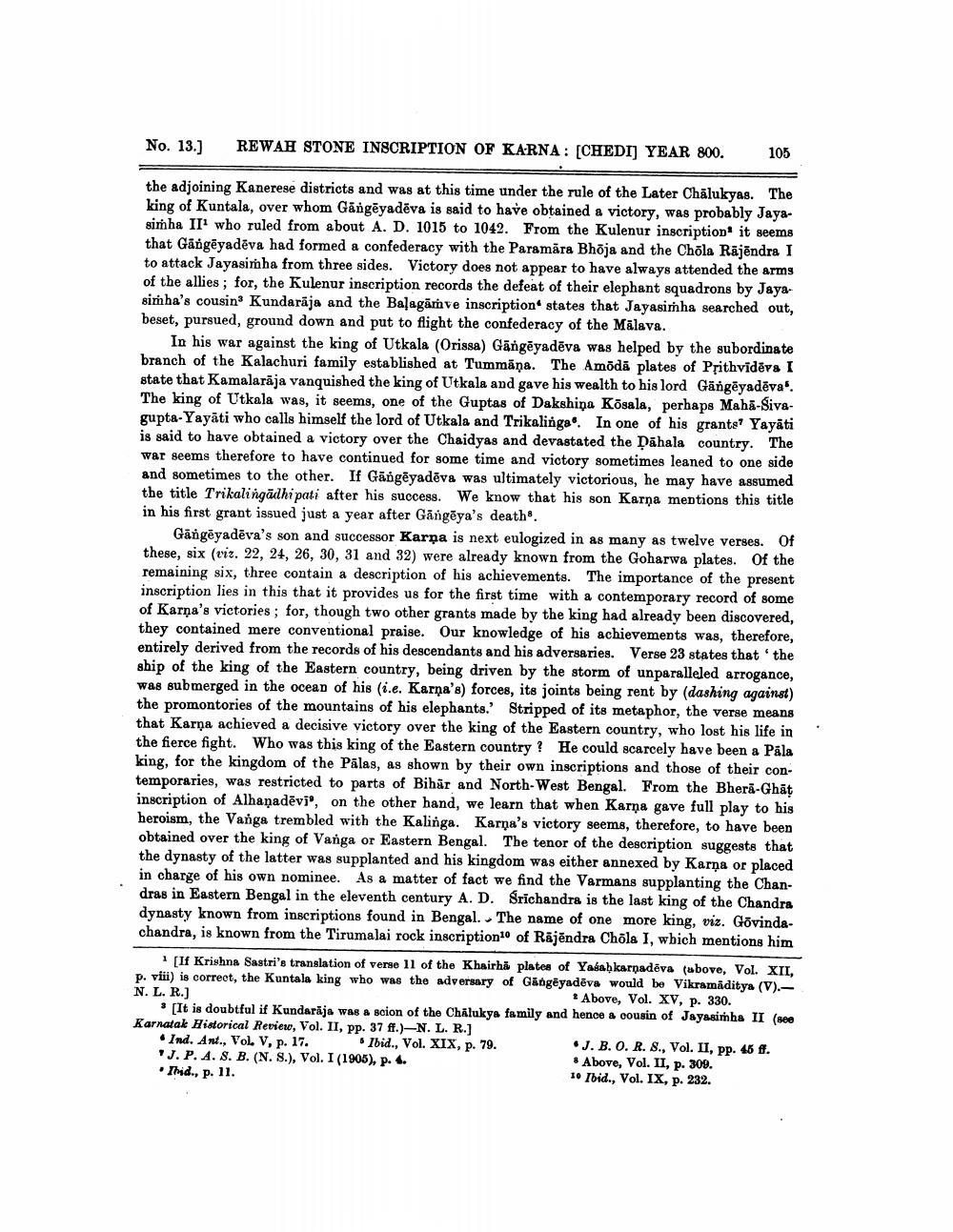________________
No. 13.)
REWAH STONE INSCRIPTION OF KARNA: CHEDI] YEAR 800.
105
the adjoining Kanerese districts and was at this time under the rule of the Later Chalukyas. The king of Kuntala, over whom Gängēyadēva is said to have obtained a victory, was probably Jayasimha II who ruled from about A. D. 1015 to 1042. From the Kulenur inscription' it seems that Gangēyadēva had formed a confederacy with the Paramāra Bhöja and the Chola Rājēndra I to attack Jayasimha from three sides. Victory does not appear to have always attended the army of the allies; for, the Kulenur inscription records the defeat of their elephant squadrons by Jayasimha's cousin Kundarāja and the Balagāmve inscription states that Jayasimha searched out, beset, pursued, ground down and put to flight the confederacy of the Mälava.
In his war against the king of Utkala (Orissa) Gängěyadēva was helped by the subordinate branch of the Kalachuri family established at Tummāņa. The Amõdā plates of Pțithvidēva I state that Kamalarāja vanquished the king of Utkala and gave his wealth to his lord Gängēyadēval. The king of Utkala was, it seems, one of the Guptas of Dakshina Kösala, perhaps Mahā-Sivagupta-Yayāti who calls himself the lord of Utkala and Trikalinga. In one of his grants? Yayāti is said to have obtained a victory over the Chaidyas and devastated the Pahala country. The war seems therefore to have continued for some time and victory sometimes leaned to one side and sometimes to the other. If Gang@yadēva was ultimately victorious, he may have assumed the title Trikali ngādhi pati after his success. We know that his son Karna mentions this title in his first grant issued just a year after Gängěya's death®.
Gāngéyadēva's son and successor Karna is next eulogized in as many as twelve verses. Of these, six (viz. 22, 24, 26, 30, 31 and 32) were already known from the Goharwa plates. Of the remaining six, three contain a description of his achievements. The importance of the present inscription lies in this that it provides us for the first time with a contemporary record of some of Karna's victories; for, though two other grants made by the king had already been discovered, they contained mere conventional praise. Our knowledge of his achievements was, therefore, entirely derived from the records of his descendants and his adversaries. Verse 23 states that the ship of the king of the Eastern country, being driven by the storm of unparalleled arrogance, was submerged in the ocean of his (i.e. Karna's) forces, its joints being rent by (dashing against) the promontories of the mountains of his elephants.' Stripped of its metaphor, the verse means that Karna achieved a decisive victory over the king of the Eastern country, who lost his life in the fierce fight. Who was this king of the Eastern country? He could scarcely have been a Pala king, for the kingdom of the Palas, as shown by their own inscriptions and those of their contemporaries, was restricted to parts of Bihär and North-West Bengal. From the Bherā-Ghāt inscription of Alhaņadēvj', on the other hand, we learn that when Karna gave full play to his heroism, the Vanga trembled with the Kalinga. Karna's victory seems, therefore, to have been obtained over the king of Vanga or Eastern Bengal. The tenor of the description suggests that the dynasty of the latter was supplanted and his kingdom was either annexed by Karna or placed in charge of his own nominee. As a matter of fact we find the Varmans supplanting the Chandras in Eastern Bengal in the eleventh century A. D. Srichandra is the last king of the Chandra dynasty known from inscriptions found in Bengal. The name of one more king, viz. Govindachandra, is known from the Tirumalai rock inscription of Rajendra Chola I, which mentions him
1 [If Krishna Sastri's translation of verse 11 of the Khairha plates of Yabahkarnadēva (ubove, Vol. XII, p. viii) is correct, the Kuntala king who was the adversary of Gangēyadēva would be Vikramaditya (V).N. L. R.)
* Above, Vol. XV, p. 330. [It is doubtful if Kundaraja was a scion of the Chalukya family and hence a cousin of Jayasinha II (see Karnatak Historical Review, Vol. II, pp. 37 ff.)-N. L. R.] • Ind. Ant., VoL V, p. 17. Ibid., Vol. XIX, p. 79.
.J. B. O. R. 8., Vol. II, pp. 45 f. J.P. 4. S. B. (N. S.), Vol. I (1905), p. 4.
* Above, Vol. II, p. 309. Thid., p. 11.
1. Ibid., Vol. IX, p. 232.




